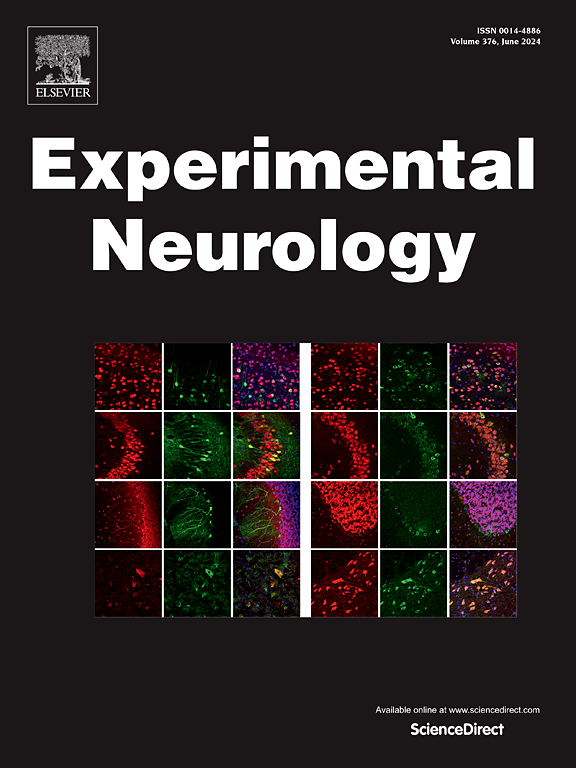胸腔爆炸诱发脑损伤时,DDAH1缺乏会加重BBB破坏和氧化应激,从而加剧脑血管内皮功能障碍。
IF 4.6
2区 医学
Q1 NEUROSCIENCES
引用次数: 0
摘要
随着恐怖事件和地下爆炸事件在全球范围内的日益频繁,胸腔爆炸暴露导致的脑损伤因其损伤器官、后续社会和经济负担而受到更多关注。据报道,二甲基精氨酸二甲氨基水解酶 1(DDAH1)在调控血管内皮损伤修复和血管生成中发挥重要作用,但其在胸部爆炸诱发的脑损伤中的作用仍有待解释。本研究旨在探讨DDAH1对胸部爆炸诱导的脑损伤的作用机制。将 40 只 C57BL/6 野生型小鼠和 40 只 DDAH1 基因敲除小鼠随机平均分为对照组和爆炸组。通过伊文思蓝试验检测血脑屏障(BBB)的完整性。通过 ELISA 检测血清炎症因子、一氧化氮(NO)含量和不对称二甲基精氨酸(ADMA)水平。HE染色和活性氧(ROS)检测用于观察组织病理学变化。Western blot用于检测与氧化应激、紧密连接、局灶粘附、血管内皮损伤和DDAH1/ADMA/eNOS信号通路相关的蛋白质。DDAH1 缺乏会加重胸腔爆破引起的 BBB 渗漏、炎症反应和炎症相关因子水平的升高。此外,DDAH1缺乏还增加了ROS的产生、MDA和IRE-α的表达。在脑血管内皮功能障碍方面,DDAH1缺乏会增加MCAM、FN1、LIMK1、VEGF、MMP9、Vimentin和N-cadherin的表达,同时降低FMR1、Occludin、claudin-3、claudin-5、Lyn、LIMA1、Glrb、Sez6、Dystrophin的表达和VASP的磷酸化。同时,DDAH1缺乏会加剧爆炸诱导的ADMA增加和eNOS活性及NO含量的降低。因此,我们得出结论,在胸腔爆炸诱导的脑损伤中,DDAH1可通过抑制ADMA信号传导和提高eNOS活性来预防脑血管内皮功能障碍及相关损伤。本文章由计算机程序翻译,如有差异,请以英文原文为准。
DDAH1 deficiency exacerbates cerebral vascular endothelial dysfunction by aggravating BBB disruption and oxidative stress in thoracic blast-induced brain injury
As terrorist incidents and underground explosion events have become more frequent around the world, brain injury caused by thoracic blast exposure has been more highlighted due to its injured organ, subsequent social and economic burden. It has been reported dimethylarginine dimethylaminohydrolase 1 (DDAH1) plays important roles in regulating vascular endothelial injury repair and angiogenesis, but its role in thoracic blast-induced brain injury remains to be explained. This study seeks to investigate the mechanism of DDAH1 on thoracic blast-induced brain injury. 40 C57BL/6 wild type mice and 40 DDAH1 knockout mice were randomly and equally divided into control group and blast group, respectively. The integrity of blood-brain barrier (BBB) was detected by Evans blue test. The serum inflammatory factors, nitric oxide (NO) contents, and asymmetric dimethylarginine (ADMA) levels were determined through ELISA. HE staining and reactive oxygen species (ROS) detection were performed for histopathological changes. Western blot was used to detect the proteins related to oxidative stress, tight junction, focal adhesion, vascular endothelial injury, and the DDAH1/ADMA/eNOS signaling pathway. DDAH1 deficiency aggravated thoracic blast-induced BBB leakage, inflammatory response, and the increased levels of inflammatory-related factors. Additionally, DDAH1 deficiency also increased ROS generation, MDA and IRE-α expression. Regarding cerebral vascular endothelial dysfunction, DDAH1 deficiency increased the expression of MCAM, FN1, LIMK1, VEGF, MMP9, Vimentin and N-cadherin, while lowering the expression of FMR1, Occludin, claudin-3, claudin-5, Lyn, LIMA1, Glrb, Sez6, Dystrophin, and phosphorylation of VASP. Also, DDAH1 deficiency exacerbated explosion-induced increase of ADMA and decrease of eNOS activity and NO contents. Thus, we conclude that DDAH1 could prevent cerebral vascular endothelial dysfunction and related injury by inhibiting ADMA signaling and increasing eNOS activity in thoracic blast induced brain injury.
求助全文
通过发布文献求助,成功后即可免费获取论文全文。
去求助
来源期刊

Experimental Neurology
医学-神经科学
CiteScore
10.10
自引率
3.80%
发文量
258
审稿时长
42 days
期刊介绍:
Experimental Neurology, a Journal of Neuroscience Research, publishes original research in neuroscience with a particular emphasis on novel findings in neural development, regeneration, plasticity and transplantation. The journal has focused on research concerning basic mechanisms underlying neurological disorders.
 求助内容:
求助内容: 应助结果提醒方式:
应助结果提醒方式:


